One Day in Bruges: The Perfect Itinerary
- By Seema
Bruges is one of Europe’s most popular cities, frequently regarded as one of the continent’s best. A visit to Bruges (or Brugge in Flemish) will make you feel like you’ve walked into a real-life fairytale.
The gorgeous Gothic town is loved for its charming cobblestone streets, perfectly preserved Gothic architecture, romantic footbridges, rich culture, mouth-watering food, and winding canals that run through the city. This delightful region in Flanders ticks all the boxes for an ideal European vacation.
Brugge is small and compact, with all of the major attractions within close proximity of one another. While you can certainly spend more time in the chocolate-box city, the best places in Bruges can be covered in just one day of sightseeing. It is best to arrive prepared to ensure that you make the most of your time and don’t miss any of the city’s highlights. Use this one-day itinerary of Bruges and immerse yourself in the magic of the picturesque town.
PS:- It may appear that there are too many things to do for a day trip. However, except for the Belfry Tower, most attractions take only 30-45 minutes to visit.
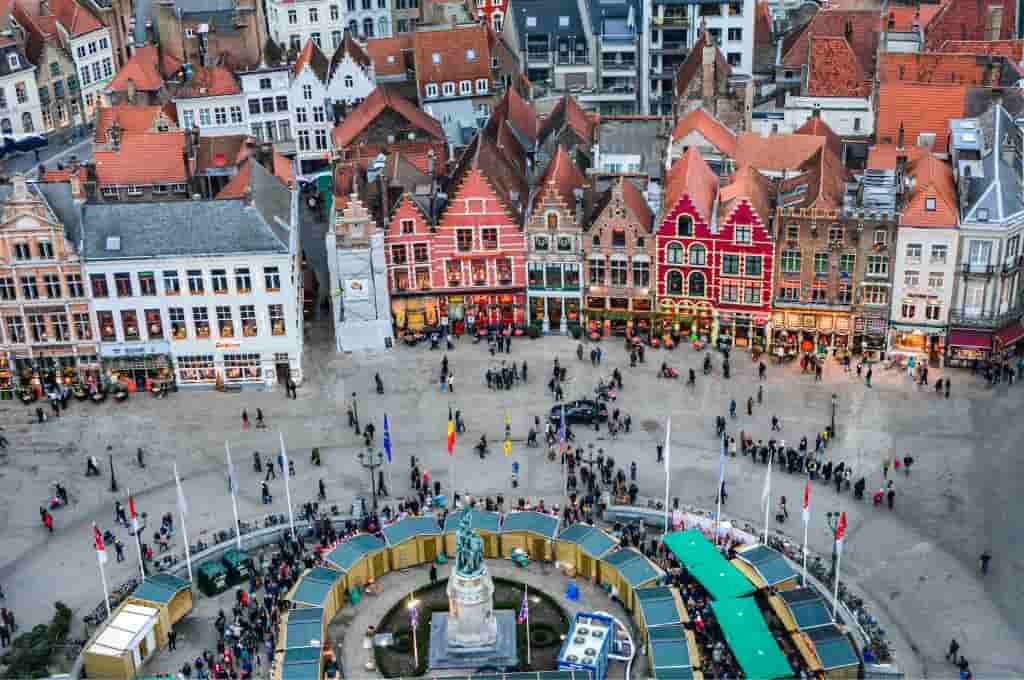
How to get to Bruges?
Situated in the northwest of Belgium, Bruges is easily accessible by day trip from neighboring cities like Ghent, Antwerp, and Brussels. Brussels is the closest major airport to Bruges.
- From Brussels, the InterCity Train takes just over an hour to reach Bruges. Trains depart every thirty minutes. You can catch a train at any of the three stations – Central Station. Brussels Midi and Brussels Nord. Bruges has just one train station. Alternatively, you can take a bus or drive there in about 90 minutes.
- From Antwerp, it takes about two hours by train and car.
- From Ghent, the train journey takes less than 30 minutes. By car, Bruges is about 50 minutes away.
Bruges can also be visited from the Netherlands or France. However, it will take you slightly longer to get there. If you are traveling from a different country, spending one night in Bruges is best.
If you don’t want to deal with the hassle of arranging your own transportation, leave it all to the professionals and join an organized tour. You won’t have to worry about any logistics —you will be picked up from a Brussels hotel and dropped off after the day trip.

Getting around Bruges
Burge’s train station sits roughly two kilometers from the historic center. Once at the station, you can easily walk anywhere. As previously stated, Bruges is very flat and walkable. If you have luggage and don’t want to walk, you can catch a bus from the bus terminal just outside the station. Every journey costs €2.50. If public transportation is not for you, Uber is easy to find.
Given your limited time, you’ll want to plan your itinerary so that you can see everything worthwhile in the charming city of Bruges. Consider taking a walking tour. They will show you the highlights as well as the hidden gems. For a more authentic tour of Bruges, you could also go on a horse-drawn carriage tour that departs from Markets Square. Another way to get around town is by bike. The streets are bike-friendly, and bicycle rentals are easy to find.
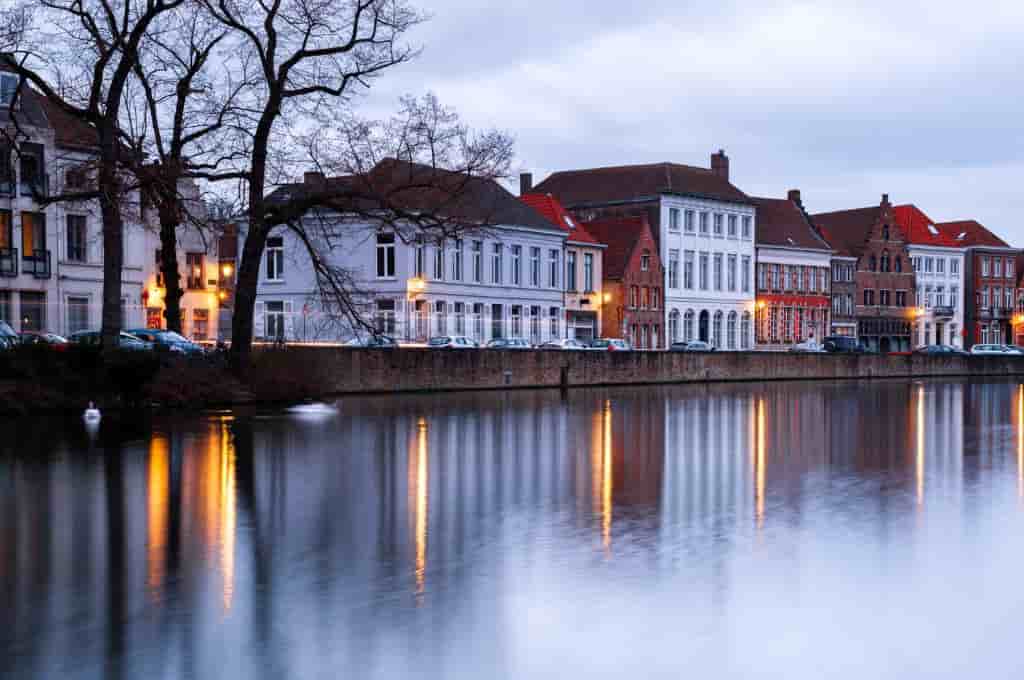
One Day Itinerary for Bruges
Morning in Bruges
Getting There: From the main station, it is a 20-minute walk to the Grote Markt.
Market Square (Grote Market), Bruges
There is no better place to begin your day in Bruges than the bustling Market Square, where most of the action takes place. It sits in the heart of Bruges’ Historical Centre and is flanked by brightly colored guild houses and some of the city’s iconic landmarks. The buildings are from different eras and have distinct architectural styles. Grab a cup of coffee from one of the many cafes that spill into the square and soak up the vibrant atmosphere. Every Wednesday, the Market Square hosts a market. If you are fortunate enough to visit Grote Market on that day, you can browse stalls selling handcrafted goods, fresh produce, and an array of local delights. The Square provides an ideal setting for the legendary Bruges Christmas Markets, which take place every November and December.
Cost: Free
Opening Hours: Always Open
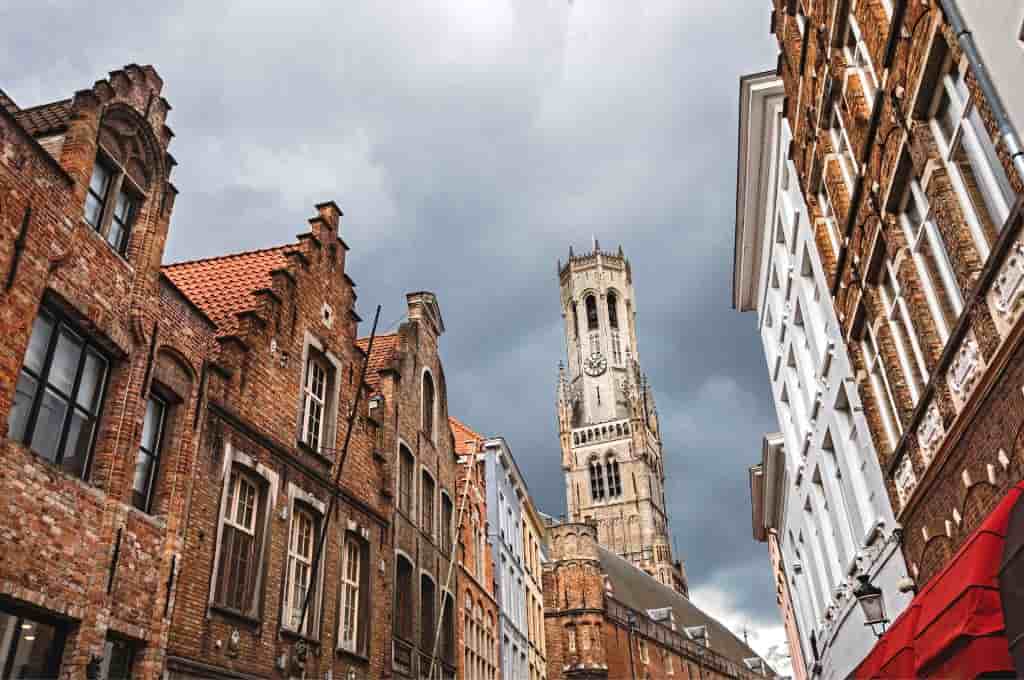
Belfry Tower (Belfort), Bruges
The imposing 83-metre-high Belfry of Bruges dominates the Market Square and is one of the most important symbols of Bruges’ rich history. If you’re up for the challenge, climb the 366-step winding spiral staircase to the top of the 13th-century tower. You will be rewarded with an unobstructed panoramic view of the city and its scenic landscapes. It also exhibits the city’s historic and still operational carillon. During the summer, you can hear the 47 melodic bells chime throughout the city. It should be noted that the number of people allowed to go up is limited, so expect to wait in line for a while. I highly recommend purchasing a ticket in advance through the Musea Brugge website.
Cost: Adults €15 | Children 7+ €13
Opening Hours: Daily from 9 am to 8 pm
Historium, Bruges
The 8-minute virtual reality experience in Market Square transports you back to medieval times via immersive projections and unique exhibits. The cost is €20 per adult. People of all ages can enjoy the engaging, interactive multimedia experience of medieval Bruges.
Cost: Adults €20 | Children (5-12) €12
Opening Hours: Daily from 10 am to 6 pm
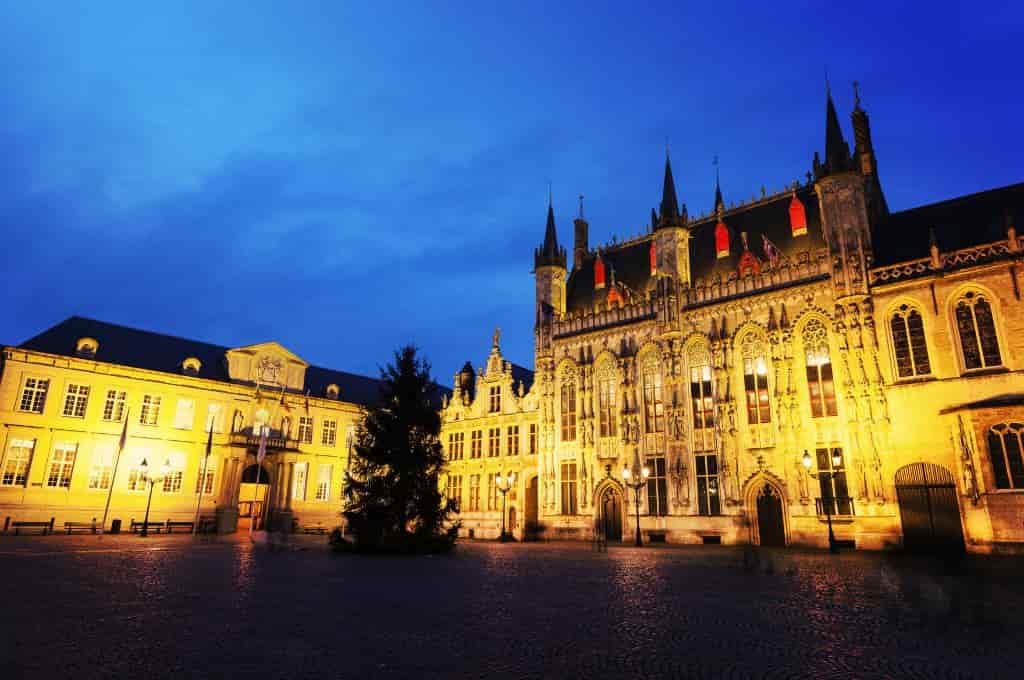
Burg Square, Bruges
Burg Square is only a three-minute walk from Market Square. Another excellent place to see Bruges’ medieval architecture. Burg Square is said to be the oldest inhabited location in Bruges. Elegant buildings from the 13th and 14th centuries surround the square, including the City Hall, the Basilica of Holy Blood, and Brugse Vrije.
Cost: Free
Opening Hours: Always Open
City Hall (Stadhuis)
City Hall is the most striking building in Burg Square. Completed in 1421, it is one of Europe’s oldest, largest, and most significant Gothic structures. The Town Hall Museum, which is housed in the City Hall, offers visitors the opportunity to view a variety of historical artifacts and learn about the rich past of Bruges.
Cost: Adults €8 | Kids (13-17) €4
Opening Hours: Daily from 9:30 am to 5 pm
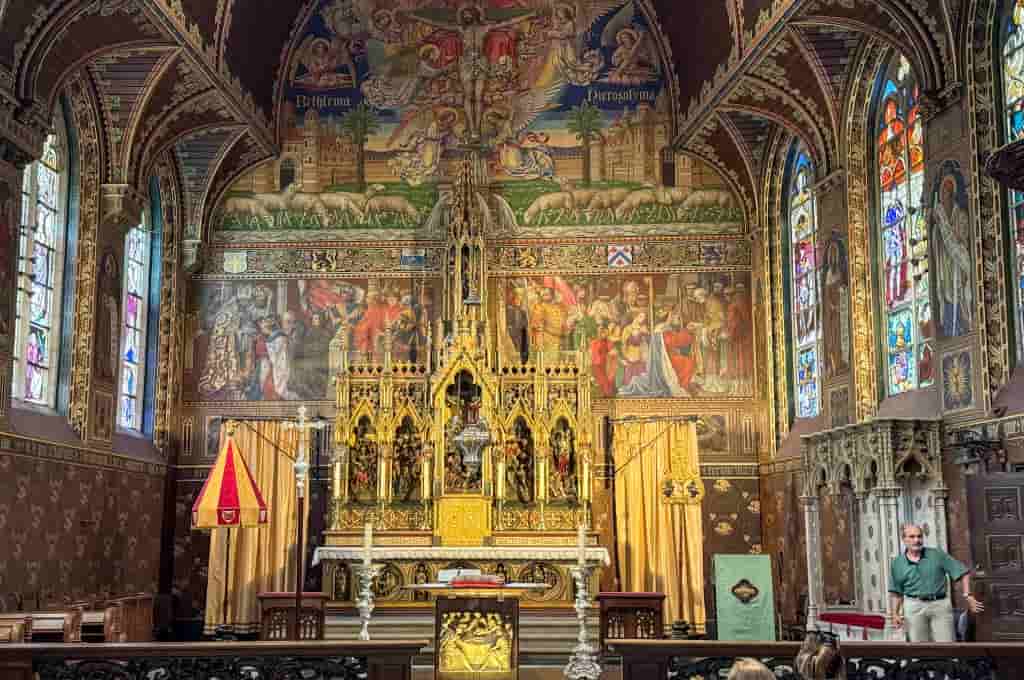
Basilica of Holy Blood, Bruges
The dark building appears small from the outside, but it feels like you’ve walked into a huge cathedral once inside. It consists of two churches dedicated to Our Lady and Saint Basil: a lower Romanesque and an upper neo-Gothic. The chapel’s most intriguing feature is located in the upper chapel. The Basilica of the Holy Blood is best known for housing a venerated relic: a vial containing drops of Christ’s blood from his crucifixion.
Cost: Free | Treasury – €5
Opening Hours: Daily from 10 am – 5:15 pm
Savor Some Waffles in Bruges
By now, you’ve probably worked up an appetite. So this is the time to indulge in one of Belgium’s most famous foods: waffles. As you stroll through the city, you will come across numerous cafes and street vendors serving waffles smothered in chocolate, berries, and cream. You’ll notice people eating waffles from tiny paper plates all around you. Belgium offers two types of waffles: Liege waffles and Brussels waffles. Brussels Waffles are light, rectangular, and crispy waffles to which we are accustomed. Liege waffles have a thicker batter and are smaller and denser, with a crispy, sugary crunch. The waffles are topped with chocolate, powdered sugar, strawberries, and whipped cream.
Chez Albert, located off the main square, is well-known for its Liege waffles. If you want a sit-down lunch or prefer Belgian waffles, go to House of Waffles. The waffles here are simply delicious. If you want something salty, you should try one of their delectable savory offerings. I picked the Belgian waffles because they were crisper and less sweet. It all depends on your preferences. Remember, whichever waffle or topping you pick, you can’t go wrong. Eating Belgian waffles is a must during your one-day visit to Bruges.
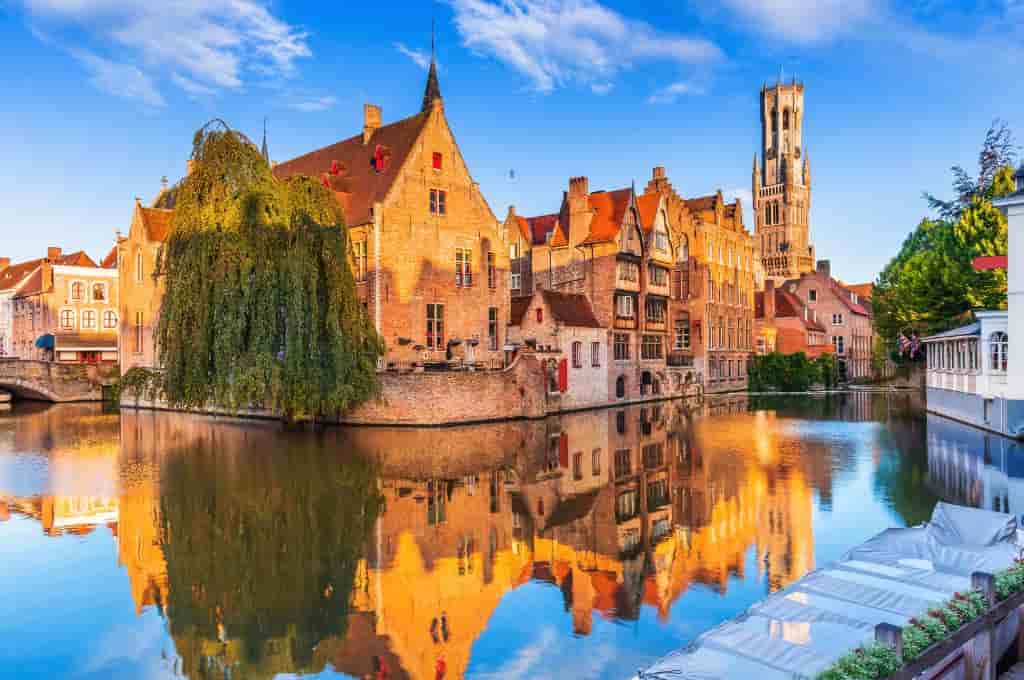
Afternoon in Bruges
Rosary Quay (Rozenhoedkaai), Bruges
You can walk to our next stop in less than 5 minutes. Rosary Quay, a charming intersection of the Dijver and Groenerei canals, is one of Bruges’ unique treasures. It sits on the canal’s corner, providing the most compelling and distinctive sights. You will enjoy beautiful views of canals, ancient bridges, and the fascinating reflections of houses in the water. The old, quaint houses seem to be tilting toward the water. It was once a popular spot for selling rosaries and is now one of Bruges’ most photographed locations. The Rosary Quay is also a popular starting point for a canal boat cruise.
Cost: Free
Opening Hours: Always Open
Take a Canal Cruise in Bruges
Bruges, also known as “the Venice of the North,” has an extensive network of waterways that snake through its historic center. Walking along the romantic canals of Bruges is a special experience, but taking a canal cruise is a must. It offers you a special vantage point from which to view the city from an entirely new angle. The boat ride will take you to hidden gems that you may miss on foot. So get ready to learn more about all of the significant landmarks, architectural marvels, and historic bridges. Along with keeping you entertained throughout the journey, the captain offers insightful commentary on the locations you will pass and Bruges itself. The cruises depart from various locations around the city every 30 minutes
Cost: Adults €15
Hours: Open Daily from 10:00 am to 6:00 pm from March to November.
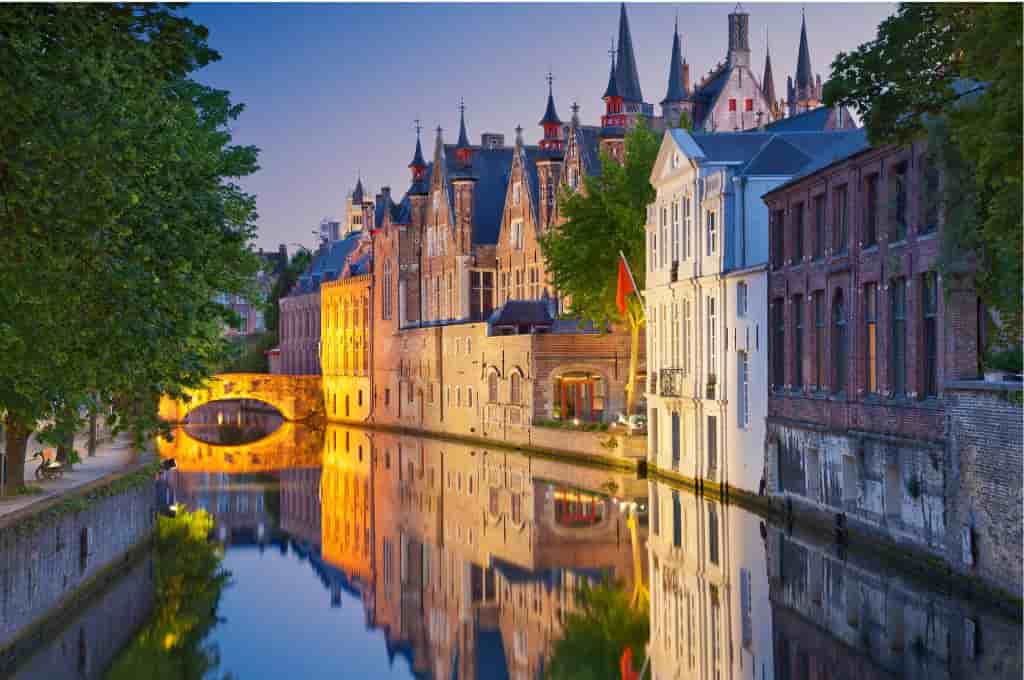
Evening in Bruges
Church of Our Lady, Bruges
After your cruise, take a ten-minute walk to the city’s main church, the Church of Our Lady. The 115-metre-high brick church tower, the world’s second tallest, highlights the craftsmanship of the developers. Built between the 13th and 15th centuries, the church is regarded as one of Europe’s most significant Gothic churches. The interior features a priceless art collection, stunning stained-glass windows, exquisite wooden carvings, and the tombs of Charles the Bold and his daughter Mary. The focal point is Michelangelo’s famous Madonna and Child sculpture, which is located in the church’s choir. This marble statue is one of the few pieces by Michelangelo that left Italy during his lifetime. The greater part of the church is free to enter, but to access the tombs and Michelangelo’s sculpture, you will need to purchase a ticket.
Cost: Adults €8 | Youth (13-17) €4
Opening Hours: Daily from 9:30 am to 5:00 pm (opens at 1 30 pm on Sundays)
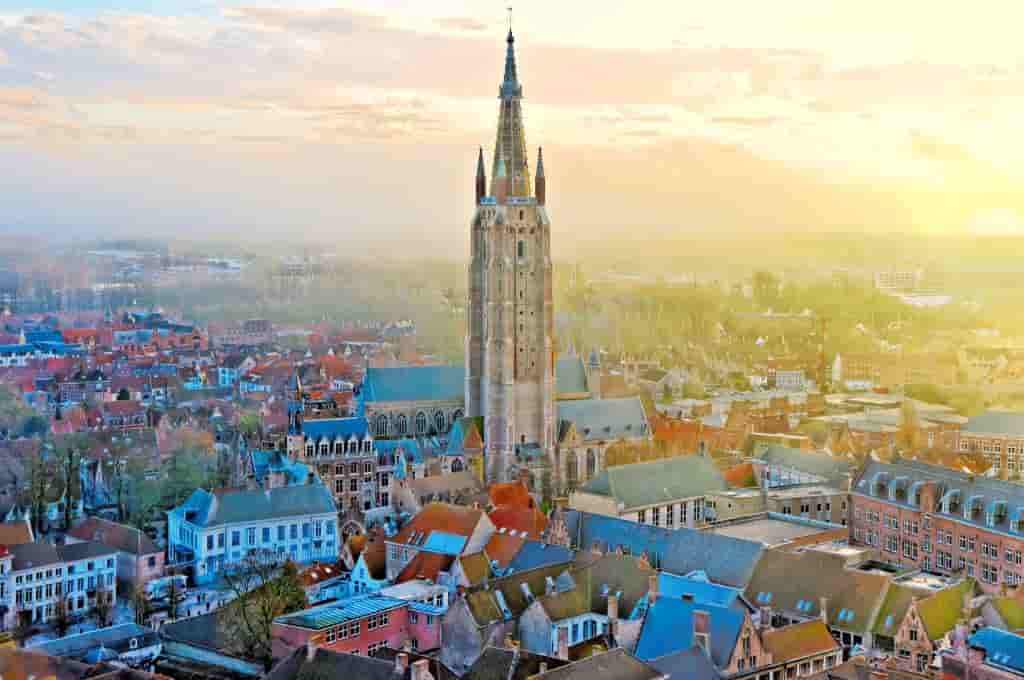
Beguinage, Bruges
It will only take you 10 minutes to walk to this unusual site. Beguinage served as a sanctuary for women who lived in the community but did not take vows or isolated themselves from the outside world. It was intended to house pious women, who were devout Christians but not nuns. The Beguinage in Bruges was founded in 1244, but the white houses and Gothic church were constructed from the 16th to 18th centuries. It is still inhabited by women, primarily the Sisters of the Order of Saint Benedict, but also by other women who wish to remain celibate. With its central green space, white-painted houses, a simple church, and 30 houses, the peaceful complex is a UNESCO World Heritage site that provides an insight into the lives of the beguines.
Cost: Free
Opening Hours: Daily from 7:30 am to 8:30 pm
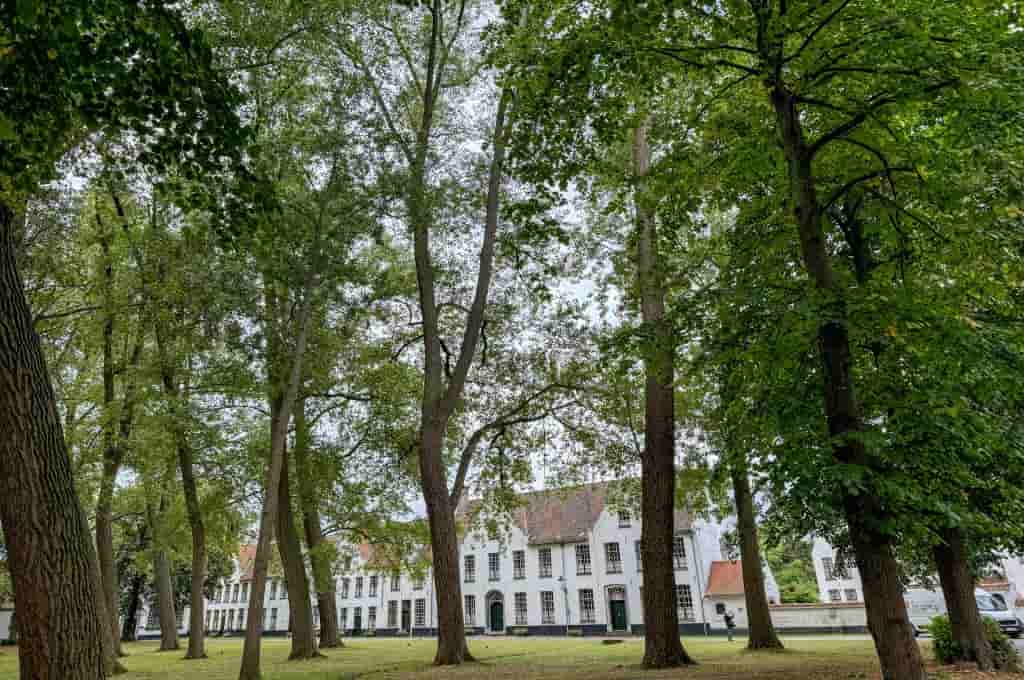
Minnewater, Bruges
If you want to escape the bustle and chaos of the touristy city center, head to Minnewater Park and spend some time relaxing or having a picnic by the lake. Minnewater lies on the outskirts of Bruges, near the train station. Walking to Minnewater will take you past some of Bruges’ picturesque canals before you reach the serene location. The region is shrouded in mystery and legend and is home to lovely foliage, Lover’s Bridge, the Lake of Love (Minnewater Lake), a medieval castle, a colony of elegant swans, and a laid-back vibe. According to legend, couples who walk over the bridge together will experience eternal love. If you’re visiting the city for a day trip, finishing at Minnewater Lake will bring you close to the train station (only a 10-minute walk), making it a perfect spot to end the day. If you’re staying in Bruges, head back to the city center after visiting Minnewater Park for a hearty Belgian meal along with locally brewed beer.
Cost: Free
Opening Hours: Always Open
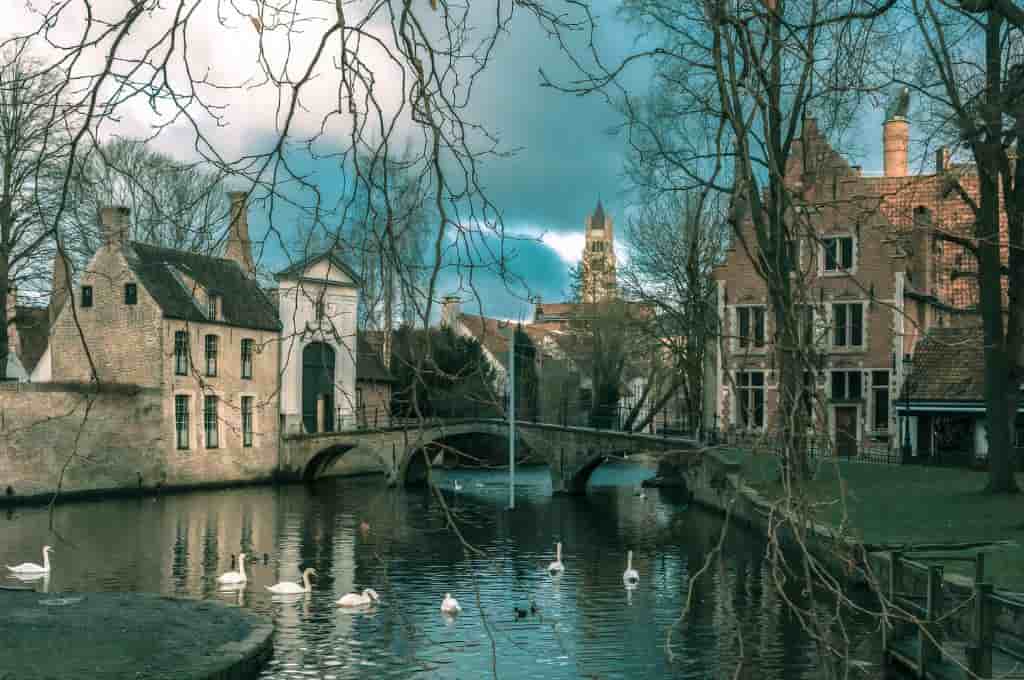
Other Things to Do in Bruges
There are a few additional things to do in Bruges. Everyone is different, so some things will pique your interest while others may not. When planning a one-day trip to Bruges, you can add or swap attractions based on your interests and time constraints.
Saint John’s Hospital – The Saint John’s Hospital, which dates back to the 13th century, was a refuge and care facility for the sick and poor. Today, the hospital is a museum with beautifully preserved wards, artifacts, artwork, and medical instruments that show how medical techniques have evolved over generations.
St-Salvador’s Cathedral – The massive cathedral is worth a quick visit during your one-day trip to Bruges. Constructed during the 12th and 15th centuries, St. Salvador’s Cathedral underwent multiple restorations in the years that followed as a result of wars or fires. It is a majestic building on the outside, but the interior is also impressive with medieval tombs, exclusive tapestry, stained-glass windows, Flemish paintings, and rare relics.
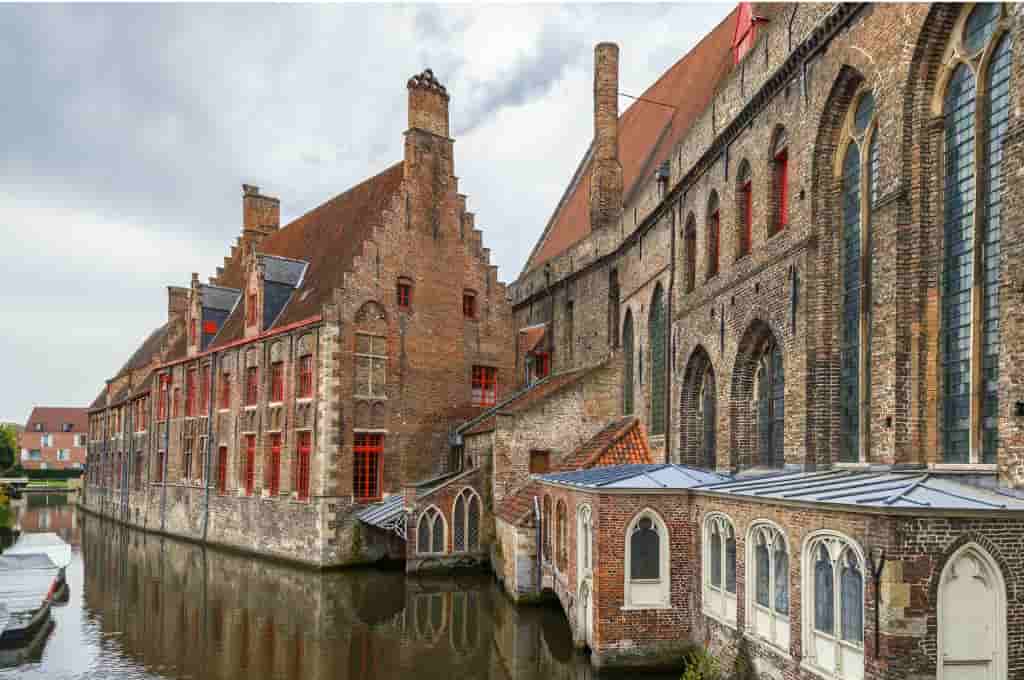
Belgian Beer – Belgium is well-known for its unique beer flavors and brewing methods. In Bruges, there is no better way to cap off the day than with a glass of beer. Brugse Zot and Straffe Hendrik are popular local beers in Bruges. De Halve Maan Brewery (The Half Moon) is a great option to sample Belgian beer and enjoy 360-degree views of the city from the rooftop. The brewery has been producing beer for six generations. A 45-minute tour of the brewery with beer samples costs €16 per adult. The last entry is at 5 pm. If you prefer a bar, 2b Beer Wall is a great pick. It has a wall of beer that looks like an encyclopedia of Belgian beer.
Boniface Bridge – The stone bridge looks like it came straight out of a fantasy and is one of the most idyllic spots in Bruges. Although the bridge was only built in 1910, its elegant architecture will leave you impressed. It’s an ideal spot to admire the canal and the half-timbered houses that line it. Look for the tiniest gothic window while you’re standing on the bridge. It is set on the wall of the Gruuthusemuseum Palace, north of the bridge.
Explore Bruges Market – Wijngaardstraat and Katelijnestraat are two of Bruges’ best shopping avenues, lined with chic boutiques, chocolate shops, and souvenir shops. Belgians are known for their chocolates, and sweet shops are stocked with everything from handmade confections to usual, tasty treats. Everyone has a favorite spot to buy chocolates in Bruges. Chocolate House, Chocolate Line, La Belgique Gourmande, and Pralinette are a few of Bruges’ most popular chocolate shops.
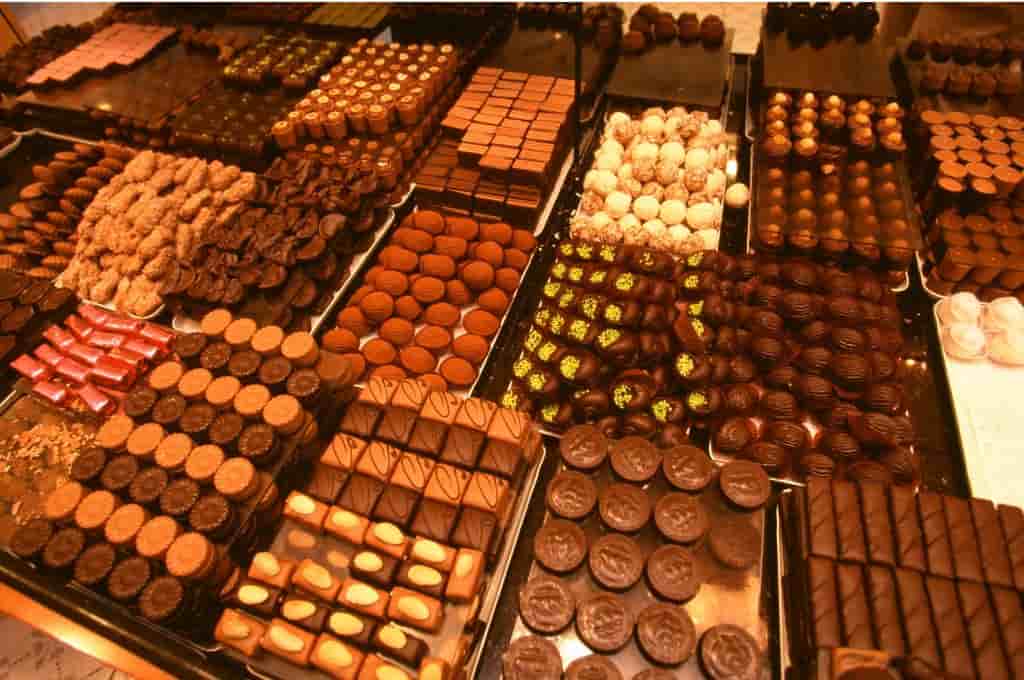
Things to Know Before Traveling to Bruges
- Bruges is beautiful all year, but the best seasons to visit are spring and autumn. The shoulder season is less crowded than summer but can be chilly at times. July and August are lovely months, but they are also the peak season. As a result, your accommodations may be more expensive, and you will encounter larger crowds. The winter months are cold and gloomy but not freezing. November and December are magical months to visit Bruges because of the festive vibes and amazing Christmas markets.
- Bruges has a very low crime rate and is quite a safe city. However, when visiting a new location, it is always a good idea to keep your wits about you and exercise common sense.
- Belgium’s currency is the euro. It’s best to keep some cash on hand for small purchases and tips, especially in weekly markets and smaller shops. The majority of restaurants and hotels accept credit cards.
- Bruges’ official language is Flemish, a variation of Dutch. However, both French and English are widely used. Most people speak English, particularly in tourist areas. Knowing a few basic phrases in the local language can be beneficial, and it is always valued by the residents.
- Walking on the cobblestone lanes requires a good pair of comfortable shoes. Also, remember to bring a raincoat because it can rain unexpectedly.
- While a day trip to Bruges can cover a lot of ground, spending the night allows you to fully immerse yourself in the city. Bruges is at its most enjoyable early in the morning, before the day-trippers arrive, and later in the evening, after they have left.

This Post Has 2 Comments
What a beautiful European city, and wow did you share a lot here. I certainly hope that you did not try to do all of that in one day.
It may look a lot but it can be easily done.